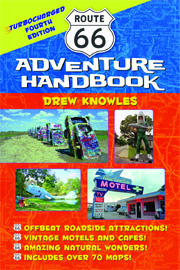You can’t accuse Drew Knowles of resting on his laurels with the fourth, “turbocharged” edition of his “Route 66 Adventure Handbook” (456 pages, $19.95, softcover, Santa Monica Press, e-book available).
 In fact, so many good changes have been made since Knowles published his first volume in 2002, you could argue that the book has become almost indispensable:
In fact, so many good changes have been made since Knowles published his first volume in 2002, you could argue that the book has become almost indispensable:
— The fourth edition has added 70 thumbnail maps of various Route 66 alignments and points of interest, making the book even more useful. It also contains brief driving directions.
— The new book contains 350 black-and-white photos.
— Knowles has significantly updated and added material. The first book contained just 240 pages. The third edition contained 384 pages. With this volume, he’s nearly doubled the page count from a decade ago and by nearly 20 percent from the previous edition.
In short, the “Route 66 Adventure Handbook” has become a superb guide to hundreds of architectural marvels, roadside oddities, museums, natural wonders, tourist traps, and historic businesses — not only along the Mother Road, but on side trips within an hour’s drive or so.
With facts arranged from Route 66’s eastern start in Chicago to the end at Santa Monica, the book also is loaded with oddball trivia and obscure attractions that may surprise even a seasoned roadie.
For instance, did you know about Nancy Ballhagen’s Puzzles, just a few miles east of Lebanon, Mo.? It stocks thousands of puzzles, including a 24,000-piece behemoth that measures 14 feet across when assembled.
Did you know a tiny crossroads town of Benonine, Texas, existed just west of the Oklahoma-Texas state line? Did you know about Manila or Hibbard in Arizona? All of those towns once appeared on atlases 50 years ago.
Because Knowles has a lot of material to cover, many of his descriptions are necessarily lean. But when he can elaborate, his writing shines. Here’s his description of Ted Drewes Frozen Custard in St. Louis:
The building itself is an important landmark, but the crucial thing is that here is a business that still believes in the older values of quality product and personal service. They’ve never “sold out” for a fast buck, and their adoring public appreciates it. Their list of mouth-watering topping is printed right on the side of the building to stoke your anticipation. Stop by some morning before opening time and watch the people begin to flock from all over. In no time at all, the place will be mobbed, and it happens virtually every day. And check to see if there’s still a mannequin peering out from one of the upstairs windows.
And here’s advice about traveling Route 66 in the Lone Star State:
You might notice during your time in the Texas panhandle that people are rather neighborly around here. Make eye contact with passing drivers and you’ll find them giving you “The Wave”: the fingers on the hand atop the steering wheel will suddenly spring upward into a sort of peacock spread that means “howdy.” Please learn to duplicate this maneuver so as not to appear out of place.
I sometimes wished the book contained more space for such detail and dry humor.
A few errors are bound to occur in this sprawling book. One is a reference to Terry Wrinkle operating the resurrected Wrink’s Market in Lebanon, Mo.; Terry closed Wrink’s again more than two years ago. Another is the entry about the Exotic World Burlesque Museum and Hall of Fame operating near Helendale, Calif. Exotic World packed up and moved to Las Vegas in 2006. Still, given the volume of material, Knowles’ batting average remains impressively high.
Those who read e-books will be pleased to know the new “Route 66 Adventure Handbook” is available in a Kindle edition (no Nook version is available). The third edition of Knowles’ book has been perched near the top of the Kindle best-seller list for Route 66-related books for many months.
Knowles’ publisher said e-book sales of the third edition of Knowles’ book were just 1 to 2 percent of the total a year ago. Now it’s 10 to 15 percent. Even roadies are catching on to the Kindle craze.
Highly recommended.